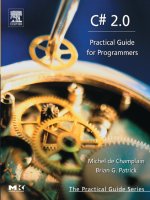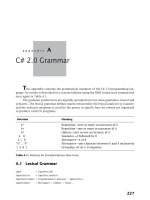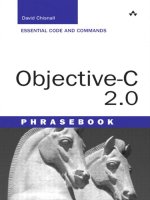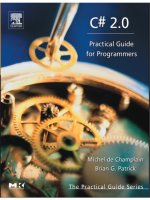Praise for C# 2.0: Practical Guide for Programmers 2005 phần 1 pdf
Bạn đang xem bản rút gọn của tài liệu. Xem và tải ngay bản đầy đủ của tài liệu tại đây (4.3 MB, 29 trang )
Praise for C# 2.0: Practical Guide for Programmers!
Great book for any C# developer! It describes the basic programming language with EBNF
notation and provides a number of practical programming tips and best practices on
program design that enable you to utilize the C# language features effectively.
– Adarsh Khare, Software Design Engineer, Microsoft
C# 2.0: A Practical Guide provides an amazing breadth of information in a compact and
efficient format, with clear and concise writing and useful code examples. It cuts right to the
core of what you need to know, covering every aspect of the C# language, an introduction
to the .NET API, and an overview of pertinent object-oriented concepts. This book tops my
recommendation list for any developer learning C#.
– David Makofske, Principal Consultant/Architect, Akamai Technologies
This book is essential for programmers who are considering system development using C#.
The two authors have masterfully created a programming guide that is current, complete,
and useful immediately. The writing style is crisp, concise, and engaging. This book is a
valuable addition to a C# programmer’s library.
– Edward L. Lamie, PhD, Director of Educational Services, Express Logic, Inc.
At last, a programming language book that provides complete coverage with a top-down
approach and clear, simple examples! Another welcome feature of this book is that it
is concise, in the tradition of classics such as Kernighan and Ritchie. The new book by
De Champlain and Patrick is the best introduction to C# that I’ve seen so far.
– Peter Grogono, Professor and Associate Chair of Computer Science, Concordia
University
The book covers the basic and the advanced features of a relatively new and well established
programming language, C#. A truly Object Oriented style is used throughout the book in
a consistent manner. C# and Object Oriented concepts are well illustrated through simple
and concise examples to hold the reader’s attention. A very well-written book.
– Ferhat Khendek, PhD, Research Chair in Telecommunications Software Engineering,
Concordia University
C# 2.0: Practical Guide
for Programmers
The Morgan Kaufmann Practical Guides Series
Series Editor: Michael J. Donahoo
TCP/IP Sockets in C#: Practical Guide for Programmers
David Makofske, Michael J. Donahoo, and Kenneth L. Calvert
Java Cryptography Extensions: Practical Guide for Programmers
Jason Weiss
JSP: Practical Guide for Java Programmers
Robert J. Brunner
JSTL: Practical Guide for JSP Programmers
Sue Spielman
Java: Practical Guide for Programmers
Zbigniew M. Sikora
The Struts Framework: Practical Guide for Java Programmers
Sue Spielman
Multicast Sockets: Practical Guide for Programmers
David Makofske and Kevin Almeroth
TCP/IP Sockets in Java: Practical Guide for Programmers
Kenneth L. Calvert and Michael J. Donahoo
TCP/IP Sockets in C: Practical Guide for Programmers
Michael J. Donahoo and Kenneth L. Calvert
JDBC: Practical Guide for Java Programmers
Gregory D. Speegle
For further information on these books and for a list of forthcoming titles,
please visit our website at />C# 2.0: Practical Guide
for Programmers
Michel de Champlain
DeepObjectKnowledge
Brian G. Patrick
Trent University
AMSTERDAM • BOSTON • HEIDELBERG
LONDON • NEW YORK • OXFORD
PARIS • SAN DIEGO • SAN FRANCISCO
SINGAPORE • SYDNEY • TOKYO
Morgan Kaufmann is an imprint of Elsevier
Senior Editor Rick Adams
Associate Editor Karyn Johnson
Publishing Services Manager Simon Crump
Project Manager Brandy Lilly
Cover Design Yvo Riezebos Design
Cover Image Photo by Steve Cole, Photodisc Green, Getty Images
Composition Cepha Imaging Pvt. Ltd.
Copyeditor Kolam Inc.
Proofreader Kolam Inc.
Indexer Kolam Inc.
Interior printer Maple Press
Cover printer Phoenix Color
Morgan Kaufmann Publishers is an imprint of Elsevier.
500 Sansome Street, Suite 400, San Francisco, CA 94111
This book is printed on acid-free paper.
©2005 by Elsevier Inc. All rights reserved.
Designations used by companies to distinguish their products are often claimed as trademarks or
registered trademarks. In all instances in which Morgan Kaufmann Publishers is aware of a claim,
the product names appear in initial capital or all capital letters. Readers, however, should contact
the appropriate companies for more complete information regarding trademarks and registration.
No part of this publication may be reproduced, stored in a retrieval system, or transmitted in any
form or by any means—electronic, mechanical, photocopying, scanning, or otherwise—without prior
written permission of the publisher.
Permissions may be sought directly from Elsevier’s Science & Technology Rights Department in
Oxford, UK: phone: (+44) 1865 843830, fax: (+44) 1865 853333, e-mail:
You may also complete your request on-line via the Elsevier homepage ()by
selecting “Customer Support” and then “Obtaining Permissions.”
Library of Congress Cataloging-in-Publication Data
Application submitted.
ISBN: 0-12-167451-7
For information on all Morgan Kaufmann publications, visit our Web site at www.mkp.com
Printed in the United States of America
0807060504 54321
To Hélène, the air that I breathe
— Michel
With love to my parents, Lionel and Chrissie
— Brian
Contents
Preface xv
1 Introducing C# and .NET 1
1.1 What Is C#?1
1.2 What Is the .NET Framework? 2
1.2.1 The .NET Virtual Machine: Common Language
Runtime 4
1.2.2 The .NET Virtual Code: Intermediate Language 4
1.2.3 The .NET Assemblies: Applications and/or
Components 4
1.3 Project Exercise 5
1.4 Syntax Notation 6
2 Classes, Objects, and Namespaces 9
2.1 Classes and Objects 10
2.1.1 Declaring Classes 10
2.1.2 Creating Objects 11
2.2 Access Modifiers 12
2.2.1 Controlling Access to Classes 12
2.2.2 Controlling Access to Class Members 12
2.3 Namespaces 14
2.3.1 Declaring Namespaces 14
2.3.2 Importing Namespaces 16
2.3.3 Controlling the Global Namespace 17
2.3.4 Resolving Namespace Conflicts 18
ix
x Contents
■
2.4 Compilation Units 19
2.4.1 Presenting a Complete C# Program 19
2.4.2 Declaring Partial Classes 21
2.5 Compilation and Execution 22
2.5.1 Using Assemblies for Separate Compilation 23
2.5.2 Revisiting Access Modifiers 24
2.5.3 Adding XML Documentation 26
3 Class Members and Class Reuse 29
3.1 Fields and Methods 29
3.1.1 Invoking Methods 30
3.1.2 Accessing Fields 32
3.1.3 Declaring Constructors 32
3.1.4 Declaring Destructors 36
3.2 Parameter Passing 37
3.2.1 Passing Arguments by Value 37
3.2.2 Passing Arguments by Reference 38
3.2.3 Passing a Variable Number of Arguments 41
3.2.4 Using the this Reference 42
3.2.5 Overloading Methods 45
3.3 Class Reuse 45
3.3.1 Using Aggregation 46
3.3.2 Using Inheritance 46
3.3.3 Comparing Aggregation and Inheritance 50
3.3.4 Using Protected Methods 51
4 Unified Type System 55
4.1 Reference Types 56
4.2 Value Types 56
4.2.1 Simple Value Types 57
4.2.2 Nullable Types 58
4.2.3 Structure Types 60
4.2.4 Enumeration Types 61
4.3 Literals 63
4.4 Conversions 64
4.5 Boxing and Unboxing 66
4.6 The Object Root Class 67
4.6.1 Calling Virtual Methods 67
4.6.2 Invoking the Object Constructor 69
4.6.3 Using Object Instance Methods 69
4.6.4 Using Object Static Methods 75
4.7 Arrays 76
4.7.1 Creating and Initializing Arrays 77
■
Contents xi
4.7.2 Accessing Arrays 78
4.7.3 Using Rectangular and Jagged Arrays 78
4.8 Strings 79
4.8.1 Invoking String Methods 80
4.8.2 Concat, IndexOf, and Substring Methods 80
4.8.3 The StringBuilder Class 81
5 Operators, Assignments, and Expressions 83
5.1 Operator Precedence and Associativity 83
5.2 Assignment Operators 84
5.2.1 Simple Assignment 84
5.2.2 Multiple Assignments 86
5.3 Conditional Operator 86
5.4 Null Coalescing Operator 87
5.5 Conditional Logical Operators 88
5.6 Logical Operators 89
5.6.1 Logical Operators as Conditional Logical Operators 90
5.6.2 Compound Logical Assignment Operators 91
5.7 Equality Operators 92
5.7.1 Simple Value Type Equality 92
5.7.2 Object Reference and Value Equality 93
5.8 Relational Operators 94
5.8.1 Type Testing 95
5.9 Shift Operators 96
5.9.1 Compound Shift Assignment Operators 97
5.10 Arithmetic Operators 97
5.10.1 Multiplicative Operators 97
5.10.2 Additive Operators 98
5.10.3 checked/unchecked Operators 99
5.10.4 Compound Arithmetic Assignment Operators 100
5.11 Unary Operators 101
5.11.1 Prefix and Postfix Operators 102
5.11.2 Explicit Casts 103
5.12 Other Primary Operators 103
5.13 Overloadable Operators 104
6 Statements and Exceptions 107
6.1 Block Statement 107
6.2 Declaration Statements 108
6.3 Embedded Statements 109
6.3.1 Expression and Empty Statements 109
6.3.2 Selection Statements 110
xii Contents
■
6.3.3 Iteration Statements 112
6.3.4 Jump Statements 114
6.3.5 checked/unchecked Statements 116
6.3.6 lock and using Statements 116
6.4 Exceptions and Exception Handling 117
6.4.1 What Is an Exception? 117
6.4.2 Raising and Handling Exceptions 118
6.4.3 Using the throw Statement 119
6.4.4 Using the try-catch Statement 121
6.4.5 An Extended Example 124
7 Advanced Types, Polymorphism, and Accessors 129
7.1 Delegates and Events 130
7.1.1 Using Delegates for Callbacks 130
7.1.2 Using Delegates for Events 133
7.1.3 Using Delegates for Anonymous Methods 135
7.1.4 Using Delegate Inferences 136
7.2 Abstract Classes 136
7.2.1 Declaring Abstract Classes 136
7.2.2 Implementing Abstract Classes 137
7.2.3 Using Abstract Classes 138
7.3 Interfaces 138
7.3.1 Declaring Interfaces 139
7.3.2 Implementing Interfaces 140
7.3.3 Using Interface Methods 141
7.4 Polymorphism and Virtual Methods 143
7.4.1 Using the Modifiers override and virtual 143
7.4.2 Adding and Removing Polymorphism 145
7.4.3 Using Dynamic Binding 146
7.5 Properties 150
7.5.1 Declaring get and set Accessors 150
7.5.2 Declaring Virtual and Abstract Properties 151
7.5.3 Declaring Static Properties 153
7.5.4 Declaring Properties with Accessor Modifiers 154
7.6 Indexers 155
7.7 Nested Types 157
7.8 Other Modifiers 159
8 Collections and Generics 163
8.1 Collections 163
8.1.1 Cloning Collections 165
8.1.2 Using List-Type Collections 165
■
Contents xiii
8.1.3 Using Dictionary-Type Collections 173
8.1.4 Using Iterator Blocks and yield Statements 178
8.2 Generics 180
8.2.1 Defining Generics 181
8.2.2 Declaring Generic Objects 183
9 Resource Disposal, Input/Output, and Threads 185
9.1 Resource Disposal 185
9.2 Input/Output 188
9.2.1 Using Binary Streams 188
9.2.2 Using Byte Streams 190
9.2.3 Using Character Streams 191
9.2.4 Reading XML Documents from Streams 192
9.3 Threads 193
9.3.1 Examining the Thread Class and Thread States 193
9.3.2 Creating and Starting Threads 194
9.3.3 Rescheduling and Pausing Threads 195
9.3.4 Suspending, Resuming, and Stopping Threads 196
9.3.5 Joining and Determining Alive Threads 198
9.3.6 Synchronizing Threads 200
10 Reflection and Attributes 211
10.1 Reflection 211
10.1.1 Examining the Reflection Hierarchy 212
10.1.2 Accessing Assemblies 212
10.2 Attributes 215
10.2.1 Using Attributes for Exception Serialization 216
10.2.2 Using Attributes for Conditional Compilation 217
10.2.3 Using Attributes for Obsolete Code 218
10.2.4 Defining User-Defined Attributes 218
10.2.5 Using User-Defined Attributes 220
10.2.6 Extracting Attributes Using Reflection 221
10.3 Where to Go from Here 223
A C# 2.0 Grammar 227
A.1 Lexical Grammar 227
A.1.1 Line Terminators 228
A.1.2 White Space 228
A.1.3 Comments 228
A.1.4 Tokens 228
A.1.5 Unicode Character Escape Sequences 228
A.1.6 Identifiers 228
xiv Contents
■
A.1.7 Keywords 229
A.1.8 Literals 229
A.1.9 Operators and Punctuators 230
A.1.10 Preprocessing Directives 230
A.2 Syntactic Grammar 231
A.2.1 Namespace, Type, and Simple Names 231
A.2.2 Types 231
A.2.3 Variables 232
A.2.4 Expressions 232
A.2.5 Statements 233
A.2.6 Namespaces 235
A.2.7 Classes 235
A.2.8 Structs 237
A.2.9 Arrays 237
A.2.10 Interfaces 237
A.2.11 Enums 238
A.2.12 Delegates 238
A.2.13 Attributes 238
A.3 Generics 238
B Predefined XML Tags for Documentation Comments 241
References 243
Index 245
Preface
Writing a short book on a comprehensive programming language was most definitely a
challenge. But such was our mandate and such is C#.
The C# programming language was first released in 2000 and has quickly established
itself as the language de rigueur for application development at Microsoft Corpora-
tion and other software houses. It is a powerful language based on the paradigm of
object-orientation and fully integrated with the Microsoft .NET Framework. Hence, C# is
architecturally neutral and supported by a vast library of reusable software.
To describe all minutiae of the C# language or to indulge in all facets of the .NET
Framework would require a tome or two. Yet the authors realize that experienced soft-
ware programmers are not looking to plough through extraneous detail but are focused
on extracting the essentials of a language, which allow them to commence development
quickly and confidently. That is our primary objective.
To realize this objective, we followed the ABCs of writing: accuracy, brevity, and
completeness. First and foremost, care has been taken to ensure that the terminology and
the discussion on the syntax and semantics of C# are consistent with the latest language
specifications, namely C# 2.0. For easy reference, those features that are new to C# 2.0 are
identified in the margins.
Second, for the sake of brevity, we strike at the heart of most features of C# with
little digression, historical reflection, or comparative analysis. Although the book is not
intended as a tutorial on object-oriented design, a few tips on good programming practice
are scattered throughout the text and identified in the margins as well.
Finally, all principal features of the C# programming language are covered, from basic
classes to attributes. The numerous examples throughout the text, however, focus on the
most natural and most common applications of these features. It is simply not possible
within the confines of two hundred pages to examine all permutations of C#.
xv
xvi Preface
■
This practical guide emerged from the experiences of the first author in teaching,
training, and mentoring professional developers in industry and graduate students at
university on the use of the C# language. Its organization is therefore rooted in several
C# jump-start courses and one-day tutorials with an intended audience of experienced
programmers. Although some background in object-oriented technology is ideal, all
object-oriented features are reviewed in the broader context before they are described
with respect to their implementation in C#.
In short, C# 2.0: Practical Guide for Programmers rests its hat on three hooks:
■
Provide a concise yet comprehensive explanation of the basic, advanced, and latest
features of the C# language. Each feature is illustrated with short, uncluttered exam-
ples. To ensure that code is error-free, the large majority of examples have been
automatically and directly extracted from source code that has been verified and
successfully compiled.
■
Cover the essentials of the .NET Framework. Modern programming languages like
Java and C# are supported by huge application programming interfaces (APIs) or
frameworks in order to tackle the flexibility and complexity of today’s applications.
Although the focus of this book is on the C# language and not on the .NET Framework,
we would be remiss to omit a basic discussion on the core functionalities of the .NET
libraries. Any greater depth, however, would far exceed our mandate.
■
Include a refresher on object-oriented concepts. The C# language is fully object-
oriented, replete with a unified type system that encapsulates the full spectrum of
types, from integers to interfaces. In addition to classes, the concepts of inheritance
and polymorphism are given their share of proportional representation as two of the
three tenets of object-oriented technology.
Organization of the Book
The book is organized into ten concise chapters and two appendices. Chapter 1 introduces
the C# programming language and the .NET Framework. It also outlines a small project that
is used as the basis for the exercises at the end of most chapters. This project is designed
to gradually meld the features of the C# language into a comprehensive solution for a
practical problem.
Unlike in books that present a programming language from the bottom up, Chap-
ters 2, 3, and 4 immediately delve into what we consider the most fundamental, though
higher-level, concepts of C#. Chapter 2 begins our discussion with classes and objects,
the first of the three tenets of object-oriented technology. We demonstrate how classes
are defined as an amalgam of behavior and state, how objects are created, and how access
to classes and to class members is controlled. Namespaces are also described as an impor-
tant aspect of “programming in the large” and how they are used to organize classes into
logical groups, to control name conflicts, and to ease the integration and reuse of other
classes within applications.
■
Preface xvii
A fuller exposé on the basic class members of C# follows in Chapter 3: methods
that define behavior and data members that define state. Constructors, destructors, and
parameter passing by value and by reference are also covered. Chapter 3 concludes with
an important discussion on class reuse and how classes derive, refine, and redefine their
behavior and state via inheritance, the second tenet of object-oriented programming. We
compare inheritance with aggregation (composition) and offer a few guidelines on their
appropriate use.
The unified type system of C# is presented in Chapter 4, showing how value and ref-
erence types are derived from the same root class called Object. All value types, including
nullable types, are fully described, along with a brief introduction to the basic notion of
a reference type. The Object class itself provides an excellent vehicle to introduce poly-
morphism (the third tenet of object-oriented programming), virtual methods, and cloning
using deep and shallow copying. The chapter ends with a presentation of two predefined
but common classes for arrays and strings.
In Chapters 5 and 6, the rudiments of C# expressions and statements are reviewed
with numerous short examples to illustrate their behavior. Expressions are built from arith-
metic, logical, relational, and assignment operators and are largely inspired by the lexicon
of C/C++. Because selection and iterative statements, too, are drawn from C/C++, our pre-
sentation is terse but comprehensive. However, whenever warranted, more time is devoted
to those features, such as exceptions and the exception-handling mechanism of C#, that
bolster its reliability and robustness.
Chapter 7 extends our discussion on the reference types that were first introduced
in Chapter 4. These advanced reference types include delegates, events, abstract classes,
and interfaces. New features such as delegate inferences and anonymous methods are
also covered. In this chapter, we carefully distinguish between the single inheritance of
classes and the multiple implementation of interfaces. Polymorphism, first mentioned with
respect to the Object root class, is illustrated once again with a comprehensive example
based on a hierarchy of counter-classes and interfaces. The two accessors in C#, namely
properties and indexers, are also presented, noting the latest specifications for property
access modifiers.
The last three chapters (8, 9, and 10) shift their focus away from the program-
ming language concepts of C# and examine some of the basic but indispensable fea-
tures of the .NET Framework. Chapter 8 extends the notion of class reuse with a look
at the different types of predefined collections and their constructors and iterators.
Although not associated with the .NET Framework itself, one of the newest features
of C# is generic classes (or templates) and is presented as a natural counterpart to
collections.
Our discussion on resource disposal begun in Chapter 3 is rounded out in
Chapter 9 along with input/output and threads. Input/output is a broad topic and is limited
here to representative I/O for binary, bytes, and character streams. Threads, on the other
hand, is a challenging topic, and the synchronization mechanisms required to support con-
current programming are carefully explained with several supporting examples. Finally,
Chapter 10 examines the use and collection of metadata using reflection and attributes,
both pre- and user-defined.
xviii Preface
■
The first of the two appendices summarizes the grammatical rules of the C# language
using EBNF notation. The second appendix provides an abridged list of the common XML
tags used for the automatic generation of web documentation.
Source Code Availability
The code for most examples and all exercises of each chapter is available and maintained
at the website www.DeepObjectKnowledge.com.
Acknowledgments
Any book goes through a number of incarnations, but none is more important than that
based on the constructive and objective feedback of its reviewers. Much improvement
on the organization and technical content of the book is due to their invaluable input,
and our sincere thanks are extended to Gerald Baugartner (Ohio State University), Eric
Gunnerson (Microsoft Corporation), Keith Hill (Agilent Technologies), Adarsh Khare
(Microsoft Corporation), David Makofske (Akamai Technologies), and Mauro Ottaviani
(Microsoft Corporation). Over the past year, we have also received timely advice and
ongoing encouragement from the kind staff at Morgan Kaufmann and Kolam. We acknowl-
edge their support with a special “tip of the cap” to Rick Adams, Mona Buehler, Karyn
Johnson, and Cara Salvatore.
Finally, we warn all potential authors that writing a book is a wonderful way to
while away the weeks and weekends. Unfortunately, these precious hours are spent apart
from our families, and it is to them that we extend our deepest appreciation for their
understanding, patience, and unconditional love.
We hope in the end that you enjoy the book. We hope that it reads well and provides
a solid introduction to the C# language. Of course, full responsibility for its organization
and content rests with the authors. And with that in mind, we defer to you, our reader, as
our ultimate source for both improvement and encouragement.
Michel de Champlain
Brian G. Patrick
■
Preface xix
About the Authors
Michel de Champlain is the President and Principal Architect of DeepObjectKnowledge
Inc., a firm that provides industry with mentoring and training support in object tech-
nologies. Michel holds a Ph.D. in Software Engineering from the École Polytechnique de
Montréal and has held university appointments at the Collège Militaire Royal de Saint-
Jean, the University of Canterbury in New Zealand, and Concordia University in Montréal.
He has also been a regular invited speaker at the Embedded Systems Conference for the last
fourteen years. Working in close collaboration with industry as well as academia, Michel
has trained thousands of people throughout Canada, the United States, Europe, and down
under in object-oriented analysis, design, and implementation. His current research inter-
ests include object-oriented languages, frameworks, design patterns, compilers, virtual
machines, and real-time microkernels.
Brian G. Patrick is an Associate Professor of Computer Science/Studies at Trent University
in Peterborough, Ontario. He first met Michel as a colleague at the Collège Militaire Royal
de Saint-Jean and has developed a close working relationship with Michel over the years.
Brian earned his Ph.D. in Computer Science from McGill University in Montréal, where he
later completed an M.B.A. in Finance and International Business. His research interests
have included heuristic search, parallel algorithms, and software reuse. He is currently
investigating job scheduling schemes for parallel applications.
chapter 1
Introducing C# and .NET
In the late 1990s, Microsoft created Visual J++ in an attempt to use Java in a Windows
context and to improve the interface of its Component Object Model (COM). Unable to
extend Java due to proprietary rights held by Sun, Microsoft embarked on a project to
replace and improve Visual J++, its compiler, and its virtual machine with a general-
purpose, object-oriented language. To head up this project, Microsoft engaged the talents
of Anders Hejlsberg, formerly of Borland and the principal author of Windows Foundation
Classes (WFC), Turbo Pascal, and Delphi. As a result of this effort, C# was first introduced
in July 2000 as a thoroughly modern object-oriented language that would ultimately serve
as the main development language of the Microsoft .NET platform.
In this short introductory chapter, we lay out the fundamental features of the
C# programming language and the .NET Framework. We also outline the requirements of a
small project that will serve as an ongoing exercise throughout the text. The chapter ends
with a few words on syntactic notation.
1.1 What Is C#?
As part of the lineage of C-based languages, C# has incorporated and exploited program-
ming language features with a proven record of success and familiarity. To that end,
most syntactic features of C# are borrowed from C/C++, and most of its object-oriented
concepts, such as garbage collection, reflection, the root class, and the multiple inheri-
tance of interfaces, are inspired by Java. Improvements in C# over Java, often with syntax
simplification, have been applied to iteration, properties, events, metadata, versioning,
and the conversion between simple types and objects.
1
2 Chapter 1: Introducing C# and .NET
■
In addition to being syntactically familiar, C# is strongly typed, architecturally
neutral, portable, safe, and multi-threaded. Type security in C# is supported in a number
of ways, including initializing variables before their use, eliminating dangerous explicit
type conversions, controlling the limits in arrays, and checking the overflow of type limits
during arithmetic operations. Its architecturally neutral intermediate format, implemented
as the Common Intermediate Language (CIL) and executed on a virtual machine, makes
C# portable and independent of its running environment.
C# is also safe. It controls access to hardware and memory resources, checks
classes at runtime, and does not allow the implicit usage and manipulation of pointers
(as C/C++ do). The explicit use of pointers, on the other hand, is restricted to sections
of code that have been designated as unsafe. With the support of a garbage collector,
frustrating memory leaks and dangling pointers are a non-issue. The C# language also
supports multi-threading in order to promote efficient interactive applications such as
graphics, input/output, and so on. Other modern features in C# include Just-in-Time (JIT)
compilation from bytecode to native code, exceptions for error handling, namespaces for
preventing type collisions, and documentation comments.
In order to promote the widespread use and acceptance of C#, Microsoft relin-
quished its proprietary rights. With the support of Hewlett-Packard and Intel, Microsoft
quickly pushed for a standardized version of C#. In December 2001, the first standard
was accepted by the European Computer Manufacturer Association (ECMA). The following
December, a second standard was adopted by the ECMA, and it was accepted 3 months
later by the International Organization for Standardization (ISO). The standardization of
C# has three principal benefits:
1. To support the portability of C# applications across different hardware architectures,
2. To foster the development of C# compilers among different manufacturers, and
3. To encourage the emergence of high-quality software tools to support the develop-
ment of C# applications.
In this text, C# 2.0 is used as the final arbiter of the language.
1.2 What Is the .NET Framework?
The .NET Framework provides a new platform for building applications that are easily
deployed and executed across multiple architectures and operating systems. This porta-
bility is achievable only because of ongoing standardization through the ECMA and ISO
organizations. In this way, the framework offers independence to languages by supplying
an international standard called the Common Language Infrastructure (CLI).
The framework was designed to be installed on top of an operating system and
is divided into two main layers, as shown in Figure 1.1: a runtime environment called
the Common Language Runtime (CLR), similar to the Java Virtual Machine, and a large
library of classes called the Framework Class Library (FCL), which provides the required
services for modern applications.
■
1.2 What Is the .NET Framework? 3
Applications Development Tools for C#, J#, C++, VB, …
Framework Class Library
Common Language Runtime
Operating System
Figure 1.1: Overview of the .NET Framework.
The bottom layer of the .NET Framework contains the CLR. The CLR provides the
runtime services to execute C# programs that have been translated into the CIL. The top
layer encapsulates all services in the FCL for user interface, control, security, data access,
Extensible Markup Language (XML), input/output, threading, and so on. User interface
(UI) services—both Window and Web Forms—support graphic interfaces and server-side
controls, respectively. ASP.NET provides control, security, sessioning, and configuration
for dynamic web pages. Data access by ADO.NET adds XML as an intermediate format for
data and supports connections to datasets using XML caches. The FCL also contains system
classes to manage I/O, execution threads, serialization, reflection, networking, collections,
diagnostics, debugging, and so on.
Applications and development tools are typically layered on top of the .NET Frame-
work. Visual Studio .NET, in particular, is a good example. It provides an integrated devel-
opment environment (IDE) that standardizes support for many programming languages,
including C#, J#, C++, and Visual Basic.
After the standardization of the C# and CLI specifications in December 2001,
Microsoft released the CLR as both a commercial implementation of the CLI runtime
virtual machine and a subset of the FCL. Since then, C# has become the programming
language of choice for developing applications in the .NET Framework. CLR, FCL, and the
C# compiler are all released as part of the .NET Framework Software Development Kit
(SDK), which is freely available from Microsoft at . At the time
of this writing, there are other .NET implementations in progress, such as the open-source
Mono and DotGNU projects. All these implementations include a C# compiler that extends
language availability to platforms other than Windows.
The C# code executed on this framework follows object-oriented development prac-
tices defined by the Common Language Specification (CLS). The CLS defines a collaboration
standard between languages and object development practices. Obviously, some older
traditional programming languages, such as COBOL and Fortran, cannot exploit the full
characteristics offered by the CLS. The Common Type System (CTS) of the .NET Framework
represents a standardized set of basic data types that permit language interoperability.
In other words, the CTS defines the rules implemented in the CLR. The CLS supports
a (common) subset of the CTS in order to allow cross-language integration. Therefore,
a CLS-compliant component can be used by applications written in other languages.
The following subsections highlight the relationships between a number of important
features of the .NET Framework and the C# programming language, including the .NET
virtual machine, .NET virtual code, and .NET assemblies.
4 Chapter 1: Introducing C# and .NET
■
1.2.1 The .NET Virtual Machine: Common Language Runtime
The CLR is the .NET virtual machine. It handles the compiling, loading, and execution of a
C# application. The compiling process employs a JIT approach that translates the CIL into
machine code as required. In addition to a traditional runtime system, it also provides
debugging and profiling functionalities. The CLR implements the CTS, which defines types
and data. Moreover, C# applications contain a complete description of their types, called
metadata, providing code visibility to other applications or tools. With this metadata, the
CLR uses reflection in order to resolve library references, link components, and resolve
types at runtime. The garbage collector is a subsystem of the CLR that cleans up memory
that is no longer needed. It frees developers of the tedious and error-prone responsibility
of recovering (deleting or deallocating) memory space allocated during object creation.
1.2.2 The .NET Virtual Code: Intermediate Language
The applications written in C# are not traditional Windows programs compiled into
machine code. Rather, the C# compiler generates CIL code, often referred to as managed
code. This code is dedicated to run safely within the .NET environment. In fact, the CLR
takes care of the back-end part of the compilation before execution, allowing the possibility
of JIT translation from CIL code into native machine code without compromising security.
On the other hand, unmanaged code, such as that generated by C/C++ compilers in the
Windows environment, uses native and potentially dangerous instructions (for example,
pointers). Like Java bytecode, CIL is also virtual machine code and is therefore completely
independent of any underlying processor architecture. It is fully cross-language compat-
ible on the .NET platform, offering at the time of this writing support for many different
programming languages. Therefore, all programs implemented in any of these languages
and compiled into CIL may share components without any extra effort.
1.2.3 The .NET Assemblies: Applications and/or Components
An assembly is the logical unit of deployment in .NET and encompasses two kinds of
implementation units: applications (.exe) and components (.dll
1
). Whereas applications
represent fully executable C# programs, components represent core reusable objects that
provide basic services to build up applications. Indeed, Microsoft prefers to call C# a
component-oriented rather than an object-oriented programming language.
Each assembly is either private or public and contains a manifest (a set of meta-
data) that provides information about its implementation units, such as name, owner,
version, security permissions, culture, processor, operating system, public key signa-
ture, and all other needed resources (such as bitmaps). Private assemblies are used only
by the application that installed them, but public (shared) assemblies are stored in a
repository maintained by the .NET Framework called the Global Assembly Cache (GAC).
1
DLL stands for Dynamic-Link Library and refers to a class library in Visual Studio .NET.
■
1.3 Project Exercise 5
Finally, because every assembly contains version information, the CLR is able to handle
multiple versions of the same component on the same platform.
1.3 Project Exercise
Throughout this text, the exercises at the end of most chapters are based on a small project.
The project was chosen to offer a nice continuity among the exercises and to provide the
reader with a practical application that can be used, reused, and modified. All the source
code for the exercises is available and maintained on the web site of DeepObjectKnowledge
().
The project consists of two distinct applications, each of which will be presented
incrementally throughout the text. The first application allows a user to enter, modify, or
delete an organization, its domain, and its e-mail format. Using the keywords First(F)
and Last(L), e-mail formats can be represented in any number of ways, as shown below
for the contact name John Smith.
Email Format Resulting Name
First.Last John.Smith
Last.First Smith.John
F.Last J.Smith
First+Last JohnSmith
Last+First SmithJohn
The second application allows a user to enter, modify, or delete a contact’s name, organiza-
tion, and e-mail address. However, using a property file generated by the first application,
the e-mail address of the contact may also be deduced from the corresponding e-mail
format of an existing organization. The latter approach generates contact information
(in this case, the e-mail address) quickly and accurately.
Using a three-tier design approach, the application is divided into three distinct
subsystems (Figure 1.2). Each subsystem is a layer that has been decoupled as much as
possible to promote the reusability of classes. These subsystems are as follows:
■
Presentation, which isolates user inputs and outputs,
■
Business, which represents domain objects that perform specific processing tasks,
and
■
Data, which loads information from files or databases to domain objects, and also
saves information from domain objects to files or databases.
Later on, each subsystem is represented by a namespace.
In order to remain focused on the features of the C# language and on the principles
of good design, the project is built on the simplicity of a text user interface (TUI) for a
console application. But as shown in Figure 1.2, the three-tier design easily allows one
6 Chapter 1: Introducing C# and .NET
■
Presentation
Business
Data
TUI GUI
Domain Objects
Files Database
Figure 1.2: Three-tier design of our project exercise.
to reuse the business and data layers with a different presentation subsystem, such as a
graphical user interface (GUI). Although files are used in this text as the internal persistent
medium to save and store information, one can also reuse the presentation and business
layers with a database instead of files in the data layer. Whether we are dealing with TUIs or
GUIs, or databases or files, we are reusing the same domain objects in the business layer.
The three-tier design therefore provides a flexible structure for this application that can be
customized for other projects. It avoids a monolithic application where the replacement
of one layer has a domino effect on all other classes in the project.
1.4 Syntax Notation
In this text, the Extended Backus–Naur Form (EBNF) notation, which is summarized in
Table 1.1, is used to define the syntax rules (or productions)oftheC# programming lan-
guage. The EBNF notation was chosen for its conciseness and readability. On rare occasion,
an EBNF definition in the text may be simplified and noted as such for expository purposes.
However, the full EBNF definition of C# given in Appendix A is well over half the length of
the equivalent BNF definition provided by the language specification itself.
Each production describes a valid sequence of tokens called lexical elements. Non-
terminals represent a production and begin with an uppercase letter. Terminals are either
keywords or quoted operators. Each production is terminated by a period, and parentheses
are used for grouping.
Notation Meaning
A* Repetition—zero or more occurrences of A
A+ Repetition—one or more occurrences of A
A? Option—zero or one occurrence of A
AB Sequence—A followed by B
A|B Alternative—A or B
"0" "9" Alternative—one character between 0 and 9, inclusive
(AB) Grouping—of an ABsequence
Table 1.1: Notation for Extended Backus–Naur Form.
■
1.4 Syntax Notation 7
For example, identifiers and numbers are defined in most programming languages by the
following four productions:
Identifier = Letter (Letter | Digit)* .
Number = ("-" | "+")? Digit+ .
Letter = "a" "z" | "A" "Z" .
Digit = "0" "9" .
According to these rules, an Identifier must begin with a Letter and is followed by zero
or more Letter(s) or Digit(s). Hence, the following identifiers are valid:
Pentium SuperH x86
A Number, on the other hand, is preceded by an optional plus or minus sign followed by at
least one digit.
The EBNF notation can also be used to express command-line syntax. For example,
CsharpCompilerCommand = "csc" Option* File+ .
Option = "/help" | "/target:<file>" | "/nowarn:<level>" | "/doc".
Here, the C# compilation command csc may have an empty sequence of options followed
by at least one source file.
In order to simplify the EBNF rules in such a large grammar as C#, we assume that:
<non-terminal>s = <non-terminal>+
is equivalent to:
<non-terminal>s
and that:
<non-terminal>List = <non-terminal> ( "," <non-terminal> )*
is equivalent to:
<non-terminal>List
Based on the preceding simplifications, the following productions:
Block = "{" Statements? "}" .
Statements = Statement+ .
Statement = ExprList ";" .
ExprList = Expr ( "," Expr )* .
can be reduced to:
Block = "{" Statements? "}" .
Statement = ExprList ";" .









